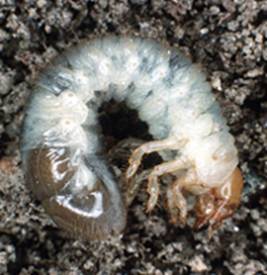This is the time of year to target for grub control. Whether your grub control products were applied a month ago, last week or are to be applied next week, the time when they actually do their work is early August. This is because grub eggs usually hatch by the end of July in the southern counties, early August in central Indiana and mid-late August in the northern counties. Egg hatch is the time that grubs are most susceptible to any pesticide, thus is the target period.
Overall, beetle activity around the state has been light again this year. However, light or not, insecticide applications may be the only reasonable option for some situations. When making grub control decisions remember that there are 3 strategies to keep in mind when it comes to insecticide applications.

(1) Preventative Control: Preventative grub applications are made in areas with a history of repeated grub damage. Preventative insecticides such as Clothianidin, Imidacloprid, Thiamethoxam, or Chlorantraniliprole can be used early in the season because they remain effective in the soil for long periods of time. These may be equally or even more effective when used in an early curative approach, if they are specifically used for grub control.
Efficacy can decrease in the late season (Fall time) when grubs become more mature. The insect growth regulator, Halofenozide, also can be used preventively but applications should definitely target early-instar larvae.
(2) Early Season Curative Control: Curative control measures can be taken in early August in response to high populations of adult beetles or even high numbers of 1st and 2nd larval instars. These applications are generally made before turf damage occurs. Carbamates and organophosphates have often been used in this situation, however, a 2nd application is sometimes necessary. The pesticides listed as preventatives can also be extremely effective if applied at this time. Post-application irrigation is necessary in order to improve efficacy.
(3) Late Season Curative control: Once grub damage occurs in late fall, insecticides with good contact activity can be applied in an attempt to prevent further damage to the turf. Chloronicotinyls (Clothianidin, and Thiamethoxam) are useful in this case, although the efficacy of Imidacloprid is somewhat reduced.
Similar to early season curative controls, carbamates and organophosphates can be used because they have a good contact activity and they are usually fast acting. Anthranilic diamides (Chlorantraniliprole) can be used to stop grubs from feeding but does not cause quick death. In this situation, effective education and communication is required for the client to be comfortable with the results.